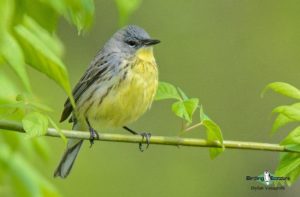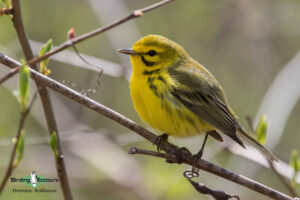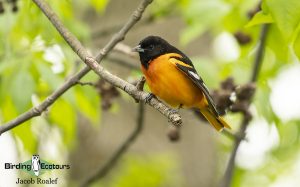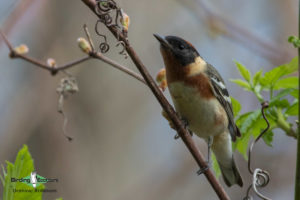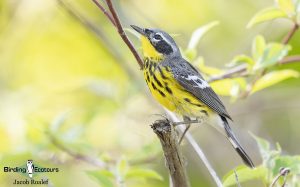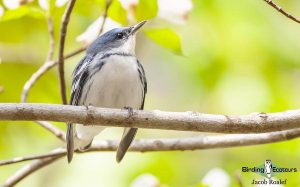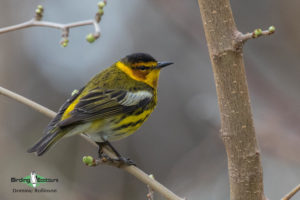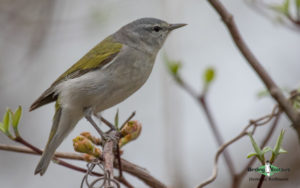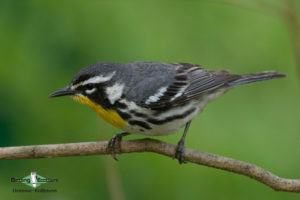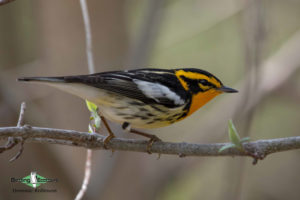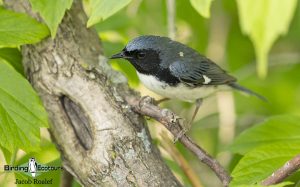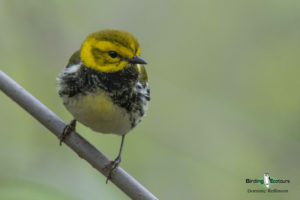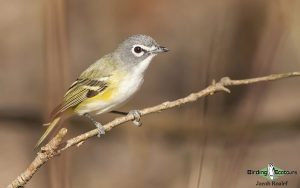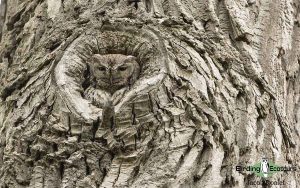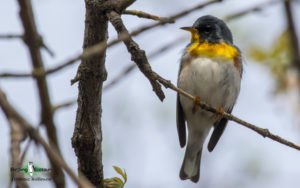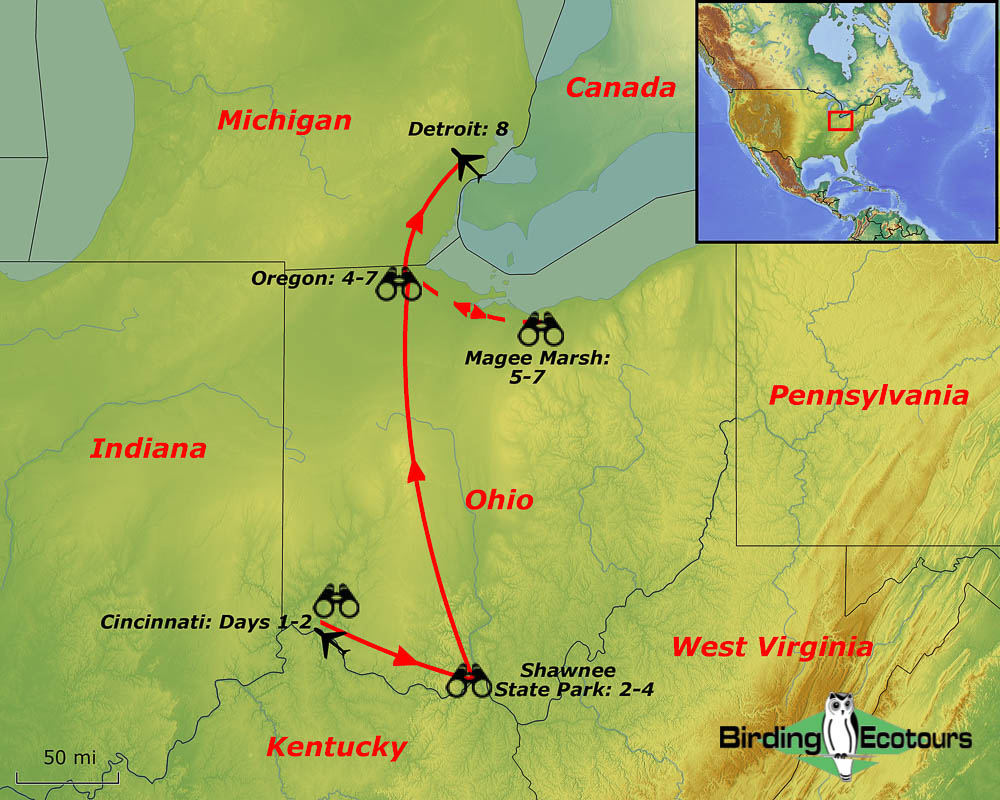Birding Tour USA: Ohio – Eastern Warblers and Spring Migration Spectacular
Ohio Birding Tour – Eastern Warblers and Spring Migration Spectacular
May 2026/2027
On this Ohio birding tour, we have a realistic chance of finding nearly every eastern wood warbler, plus so many other migrants and residents. These New World warblers are arguably America’s most iconic and beautiful birds and one of the big reasons for world birders to visit the USA. This is the ideal tour to see them, often at eye-level, feeding to fuel their migration or on established breeding grounds. The birds are in bright, freshly molted spring plumage and are looking their snazzy best at this time of year.
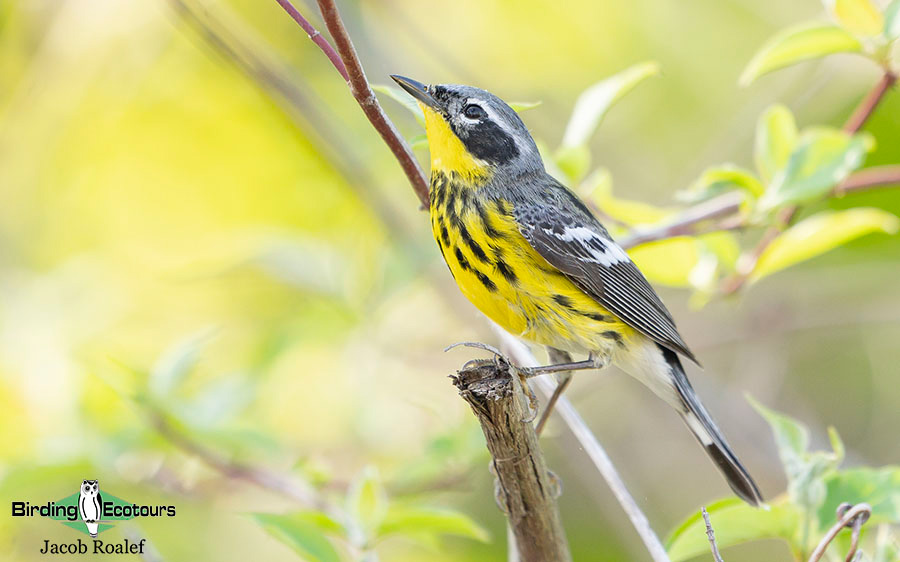 The stunning Magnolia Warbler is always a favorite warbler.
The stunning Magnolia Warbler is always a favorite warbler.
Ohio is a surprisingly underrated birding state, full of diverse habitats and migrant traps. The northern and southern portions of Ohio are quite different, each providing unique birding opportunities and species to enjoy. The southern portion hosts some incredible prairies as well as vast, beautiful old-growth forests in the foothills of the Appalachian Mountains. It is also the northernmost extent of several breeding birds, which use these amazing habitats in the spring and summer to the fullest. These include Prairie Warbler, Worm-eating Warbler, Kentucky Warbler, Blue Grosbeak, and Yellow-breasted Chat, to name just a few.
Northern Ohio is bordered by the great Lake Erie, creating expansive freshwater marshes. The birding in this area has been made famous by the Biggest Week in American Birding Festival hosted by our friends at the Black Swamp Bird Observatory. The lake is like a freshwater ocean, creating a similar obstacle for migrating birds, as they migrate along its shores before making the risky water crossing at its narrowest point. Luckily, the shorelines are full of fantastic nature preserves, parks and refuges, with great birding trails, including the world-famous Magee Marsh Wildlife Area. As birds migrate north and encounter the huge body of water, they put down into the trees along the shore to rest and feed before attempting to cross the unknown. This creates a massive build-up of birds with one mission: to fuel up before crossing the lake. Many of them take the shortest water crossing to Point Pelee, where they arrive tired and hungry; you can enjoy these incoming migrants on our custom tours here.
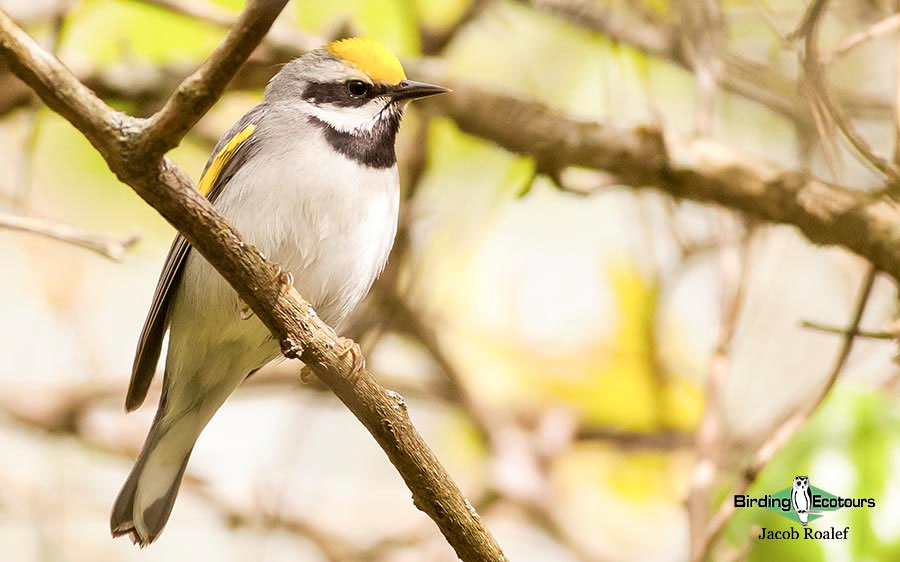
This tour highlights and targets 30+ species of wood warblers in the eastern United States by showcasing a wide array of habitats in Ohio and the true spectacle of spring migration in this fantastic birding state. We will begin in Cincinnati, Ohio, with a visit to some of its pristine local Metroparks before heading off to Shawnee State Park. The forests here are typically teeming with birds and we will target the southern specialties on the trip. After this we make the trip north for a few days of migration at Magee Marsh and surrounding parks with possible stops in Chillicothe and Columbus along the way. After some time with the jaw-dropping warbler views from the Toledo area we will head to the airport in Detroit, Michigan to wrap up our successful bird-packed adventure. When it’s all said and done, you should expect to have seen 180+ species, although we’ll most likely be pushing close to 200 eastern US birds!
It’s not all about warblers and other passerine migrants though. The north of Ohio also has some fantastic shorebird habitat, which supports tremendous numbers of birds on their journey to their breeding grounds in Canada. These beautiful birds are normally molting into their dapper breeding plumages and include Stilt Sandpiper, Short-billed Dowitcher, Wilson’s Phalarope, and upwards of 15 others.
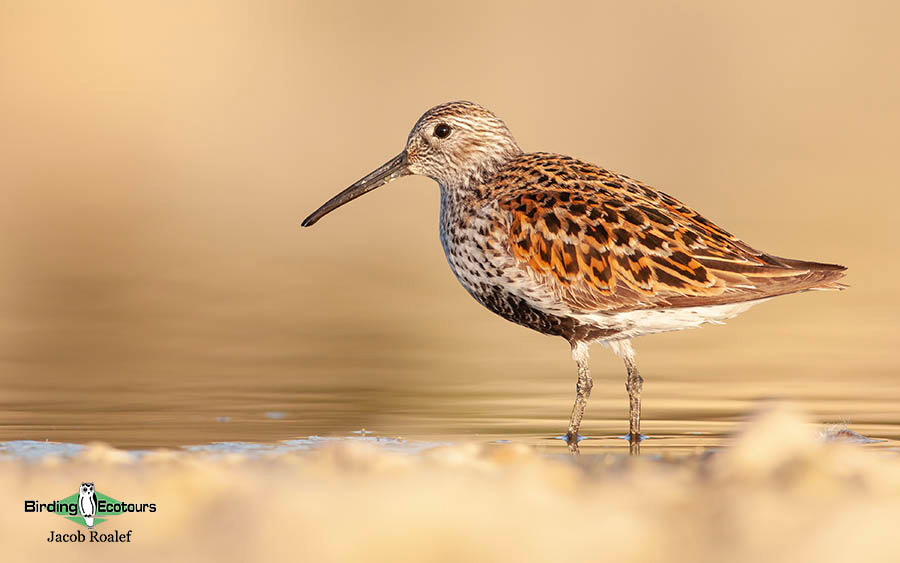
Itinerary (8 days/7 nights)
Day 1. Arrival in Cincinnati
After arrival at the Cincinnati airport (airport code CVG), you will be transferred to a nearby hotel for the evening. Depending on flight times and arrivals, we may have some time for a little birding before heading off for our first dinner of the trip. We will get to know each other a bit better and discuss the exciting birding ahead of us.
Overnight: Cincinnati
Day 2. Red River Gorge and transfer to Shawnee.
On our first full day of the trip, we will head out early and make the two-hour drive to Red River Gorge in Kentucky. We will get our first taste of eastern warblers as we hope to catch some of the migrants from the previous night and target a few of the southern-breeding species. Our top target in Kentucky will be the tricky Swainson’s Warbler as this species does not make it north into Ohio. Other breeders include Worm-eating, Hooded, and Black-and-white Warblers. Of course, other migrants like Scarlet Tanager, Baltimore Oriole, and Warbling Vireo should also be around. After a nice morning of birding, we will make our way back to Ohio and the Appalachian foothills of Shawnee State Forest.
After lunch we will begin our birding of this region with some grasslands and prairie habitats for Field Sparrow, Prairie Warbler, Eastern Towhee, and Blue Grosbeak. We will then make it to the lodge where we will spend some time birding around the grounds. Typically, there are accommodating Cerulean Warblers nearby, plus Brown Thrasher and Wood Thrush in the woods. We will enjoy dinner at the lodge before calling it a day and preparing for tomorrow.
Overnight: Shawnee State Park Lodge
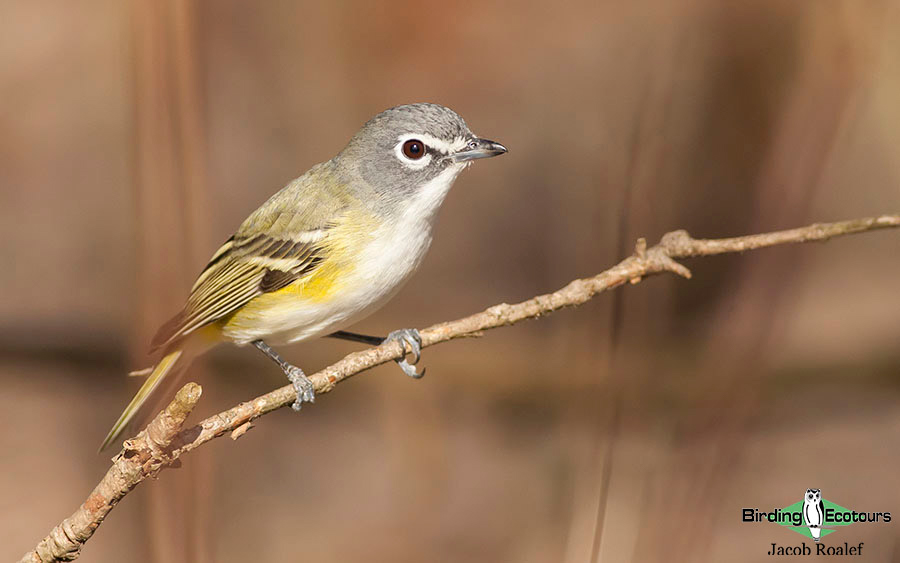
Day 3. Shawnee State Park
We will be up and out of the door before dawn to visit this 60,000-plus acres of old-growth forest. As we navigate our way up the curvy roads before dawn, we should see plenty of eye shine of Eastern Whip-poor-will in the road. The morning chorus here can be absolutely deafening with loads of migrating birds echoing through the slopes and ravines. We will start on higher grounds, as migrants typically land at the tops of canyons for a rest. As with most migration it can be hit or miss depending on the winds, but we should be able to score a bright Blackburnian Warbler glowing in the morning sun and see loads of Black-and-white Warblers scooting up trunks. After things slow down on the mountain tops, we will move back down into the ravines alongside creeks and streams. Here we will see loads of Yellow-throated Warblers and Northern Parulas. Next, we will move into areas with precipitous drops to find a true southern special, Worm-eating Warbler. These mid-to-high elevations also provide us with excellent opportunities to see the jaw-dropping blue of Cerulean Warbler up close and personal. This huge forest is filled with the skulking Ovenbird and Hooded Warbler as their songs echo throughout the entire area. In the evening we will head out to a small creek in Adams County to listen for Barred Owl and Eastern Screech Owl. This is also the only place in the entire state of Ohio where Chuck-will’s-widow breeds. Then we’ll head back to the lodge for a good night’s sleep after an action-packed day.
Overnight: Shawnee State Park Lodge
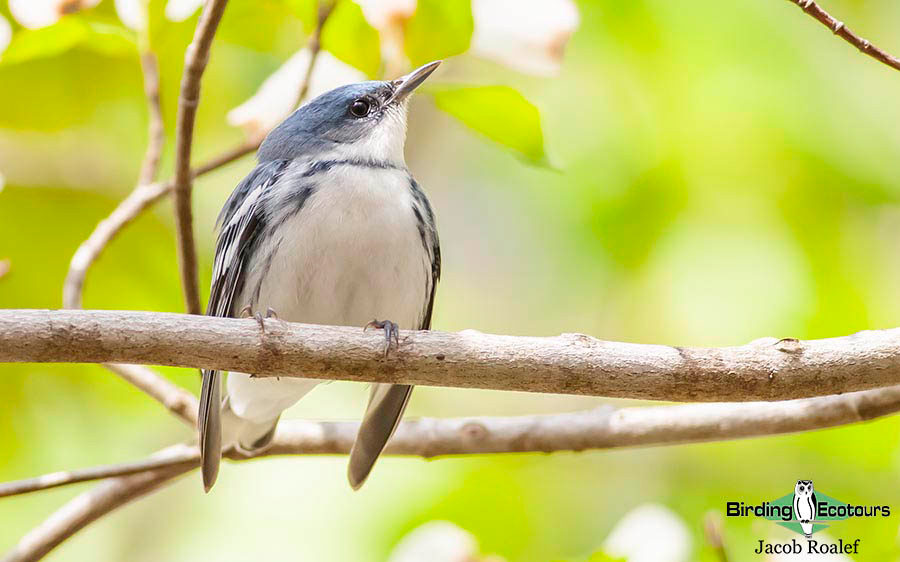
Day 4. Morning at Shawnee and transfer north
We will spend one more morning up at the top of the mountains, listening to the dawn chorus and searching for new migrants. Anything can show up in these trees, including over 20 different species of warbler, so hopefully we will be able to dig up something new that we didn’t get the previous day, such as Tennessee Warbler or Scarlet Tanager. We may also need to spend a little time cleaning up on southern specialty species. After a nice, relaxing morning of enjoying the new migrants, we will begin our long journey north towards Lake Erie. Depending on time and reports, we may make brief stops along the way in Chillicothe or Columbus before eventually getting to Oregon, Ohio, our base of operations for the next several days.
Overnight: Oregon
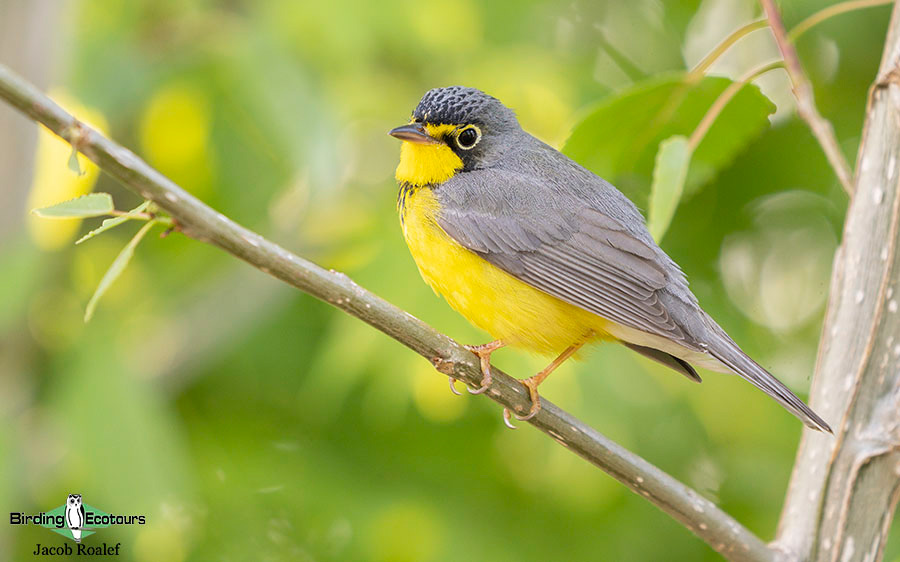
Days 5-7. Magee Marsh and Northwest Ohio
Over the next three days we will experience the true greatness and fascination of spring migration in Ohio as we visit Magee Marsh and the numerous other parks along the Lake Erie shoreline! Spending most mornings at the Magee Marsh boardwalk, we will be treated to eye-level looks at a great diversity of warblers and migrants as they drip from the trees like rain droplets. This will also give us a chance to see how drastically things can change from one day to the next with different waves of birds moving through. One day may be dominated by Chestnut-sided and Black-throated Blue Warblers and the next by Bay-breasted and Cape May Warblers, with little to none left of the previous day. Expect to experience things like Magnolia Warbler bouncing in trees right above your head and Northern Waterthrush foraging on the marshy leaf litter under the boardwalk. Like in previous days, we will take special interest in targeting any warbler or other migrant we still need for the trip, especially some of the later migrants like Wilson’s Warbler and Canada Warbler.
There is great diversity of habitats here which provide for all species of birds from warblers to shorebirds. We usually see breeding-plumage Dunlin and American Golden Plover in great numbers at the brand-new and fantastic Howard Marsh. This is a site specially managed with birds in mind, as the water levels are controlled to aid shorebirds on migration. We will also explore some unique areas to the west in Toledo like the pine and oak savanna at Oak Openings Preserve. It is here we will find one of Ohio’s breeding populations of the colorful Lark Sparrow as well as plenty of singing Blue-winged Warblers and noisy Red-headed Woodpeckers foraging in stands of dead trees.
Overnight: Oregon
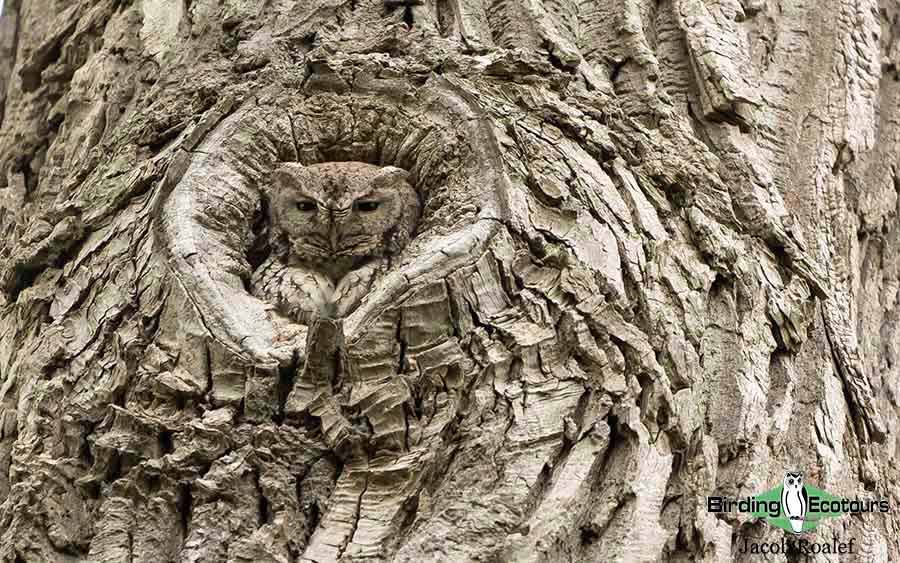
Day 8. Departure
Our final morning together may allow for a quick visit to Pearson Metropark or the boardwalk at Maumee Bay State Park to see any new migrants that came in. After this we will make the approximately 45-minute drive to Detroit International airport for drop-off and conclusion of the trip.
Please note that the itinerary cannot be guaranteed as it is only a rough guide and can be changed (usually slightly) due to factors such as availability of accommodation, updated information on the state of accommodation, roads, or birding sites, the discretion of the guides and other factors. In addition, we sometimes must use a different guide from the one advertised due to tour scheduling or other factors.
Download ItineraryUSA – Ohio: GGAS Partner Set Departure Trip Report
7 – 14 MAY 2022
DOWNLOAD TRIP REPORT
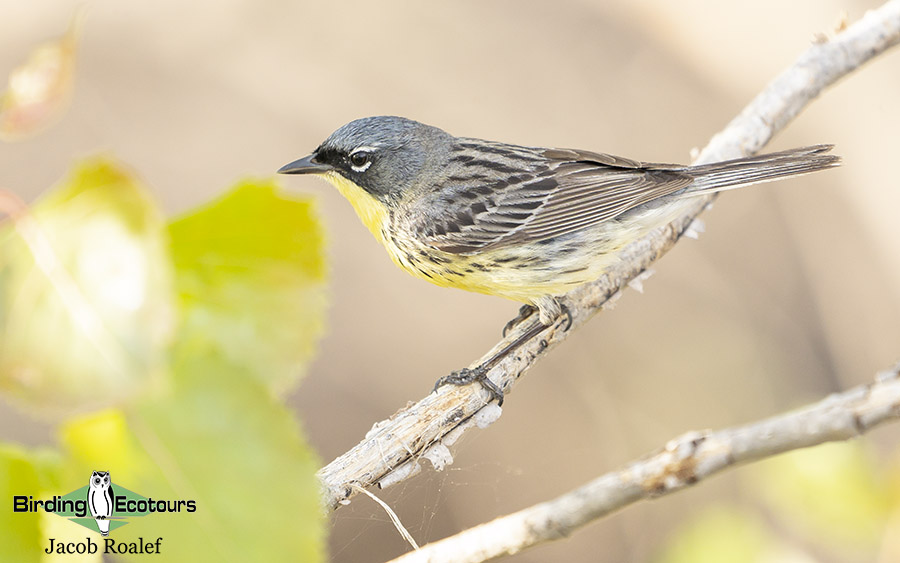
Overview
This eight-day special Golden Gate Audubon Society (GGAS) tour of Ohio commenced in Detroit in the neighboring state of Michigan on the 7th of May and completed back in Detroit on the 14th of May 2022. The tour visited many of Ohio’s great parks and wildlife areas in both the northern and southern portions of the state. These included Magee Marsh State Park, Ottawa National Wildlife Refuge, Pearson Metropark, Sharon Woods Metropark, Shawnee State Park and Oak Openings Metropark.
This tour connected with amazing and colorful migrant species and many fantastic Ohio breeding species, giving us a great list for only one week of birding together. Avian highlights included Scarlet Tanager, Eastern Whip-poor-will, Cedar Waxwing, Philadelphia and Yellow-throated Vireos, Sandhill Crane, Black-necked Stilt, Bald Eagle, Acadian Flycatcher and 34 warbler species such as Magnolia, Bay-breasted, Canada, Mourning, Golden-winged and Blackburnian Warblers. We also managed to score not one but TWO Kirtland’s Warblers, certainly a difficult and impressive feat to pull off in Ohio.
A total of 149 bird species were seen with one additional heard only species bringing the total recorded to 150. In addition to the birds, some other animals were spotted including White-tailed Deer, Muskrat, Eastern Fox Squirrel, Common Snapping Turtle, and the state endangered Blanding’s Turtle. Full bird and mammal checklists can be found at the end of the report.
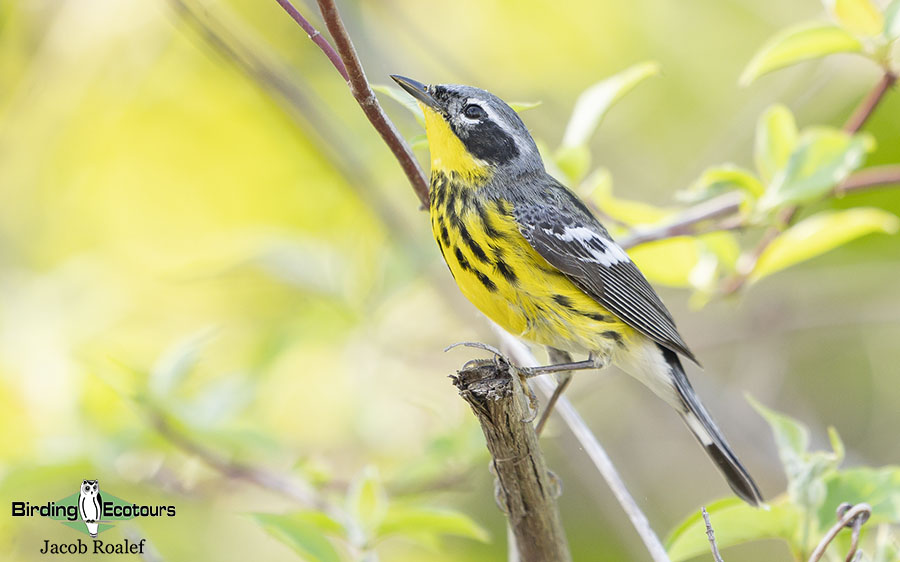
Detailed Report
Day 1, 7th May 2022. Arrival in Detroit and Ohio birding
All participants on this trip were in Detroit early so we all met up around mid-morning and headed straight to Ohio for lunch and then some afternoon birding. The first birding stop of the day was a local creamery stand with a flooded field behind it where we logged our first species for the trip: Trumpeter Swan, Bald Eagle, Great Egret and Wood Duck. From there we headed off to Pearson Metropark, hopeful to find our first warbler of the trip. The birding was a bit slow because the winds had been northerly for the previous few days, keeping birds further south. Despite this, we managed some nice species including Myrtle and Palm Warblers, Eastern Bluebird, Carolina Wren, Chipping Sparrow, Baltimore Oriole and Rose-breasted Grosbeak. Then we explored the northern portion of Pearson and added American Yellow Warbler, Tree Swallow and American Goldfinch. This was a great start to our Ohio warbler tour.
Day 2, 8th May 2022. First taste of Magee Marsh and Ottawa
We had breakfast and coffee at the hotel and then headed out for our first full day of birding. Our first stop was the famous migration hotspot of Magee Marsh and we spent an entire morning there. The entrance road was surrounded by marsh habitat and scanning through this yielded Blue-winged Teal and Trumpeter Swan. We continued to the main parking lot, slowly worked our way across the trees in the parking lot and then worked the long boardwalk trail here. Although a “slower” day in terms of migration, we still recorded six species of warblers: Black-and-white, American Yellow, Palm, Myrtle and Black-throated Blue Warblers and Common Yellowthroat. Of course, there were other lovely birds as well like White-throated Sparrow, Blue Jay, Downy Woodpecker, Grey Catbird, Belted Kingfisher and Warbling Vireo. This was certainly a good introduction to Magee Marsh and some of the migrants and resident species. It was then time for lunch at the local Blackberry Corner Tavern.
After lunch we headed out to Ottawa National Wildlife Refuge and did the auto loop, which was open at this time of year. We started off with a Purple Martin colony at the entrance, an Eastern Phoebe at the bridge and an Eastern Screech-Owl taking a snooze in a tree cavity. There were plenty of Red-winged Blackbirds throughout the drive, as well as American Yellow Warblers. About halfway through, we found some better sections of water and noted Great Blue Heron, Common Gallinule, American Coot, Gadwall and a flock of American White Pelicans flying overhead. Along the back stretch of the drive, we came across Great Horned Owl owlets, with one of the parents off in the distance watching. This was indeed a fantastic auto drive at Ottawa. Then it was time for dinner and back to the hotel for the evening.
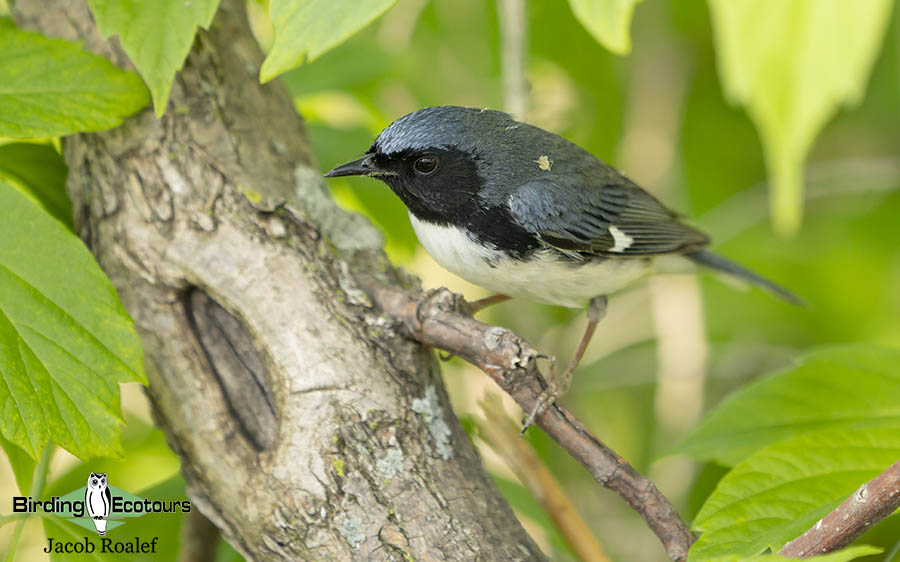
Day 3, 9th May 2022. Drive south and Sharon Woods
We headed out on the long journey to southern Ohio and Shawnee State Park. We decided to take the route through Cincinnati with a stop at the beautiful Sharon Woods Park. Due to recent winds and weather, there were definitely more migrants and bird activity here in southern Ohio than what we had seen up north. It was an absolutely perfect day to be outside birding and right away we were treated to Chestnut-sided and Blackburnian Warblers. As we ventured further into the park, we picked some jaw dropping closeups of Magnolia and Bay-breasted Warblers as well as Northern Cardinal, Swainson’s Thrush and House Wren. It was such a gorgeous day that we decided to go and fetch our lunch and head back to the park to enjoy it. It’s a good thing we did because as soon as we got back, we saw a group of birders who were on a Kirtland’s Warbler! This rare bird gave all of us amazing point-blank views. Overall, we recorded nine species of warblers at Sharon Woods before moving on.
We arrived at the foothills of the Appalachians, where we stopped at Edge of Appalachia Preserve for about 30 minutes of birding. Here we picked up our first southern breeding warbler species in the form of Prairie Warbler. Of course, we ticked a few other new trip birds as well like Field Sparrow, Black Vulture, Yellow-breasted Chat and Eastern Towhee. We continued to the lodge for dinner to cap off our long day of driving and birding.
Day 4, 10th May 2022. Shawnee State Park
Shawnee State Park is an amazing forest full of southern breeding species as well as migrants working their way north. We had the entire day to explore this area and take in the beauty of nature. We started off along Pond Lick Road with a singing Hooded Warbler, Northern Parula and Yellow-throated Vireo. We managed to catch up with Yellow-throated Warbler, before hitting the top ridge to hopefully find some new migrants. At the top we spotted an Ovenbird belting out his song, which echoed through the forest. A Black-throated Green Warbler was singing but unfortunately stayed far too high for us to enjoy. We also enjoyed the rare and state endangered Pink Lady Slipper Orchid. After the sun had risen sufficiently, we headed back down and birded some different territories, looking for breeding species. This was very successful and we picked up Kentucky, Worm-eating, Hooded and Cerulean Warblers.
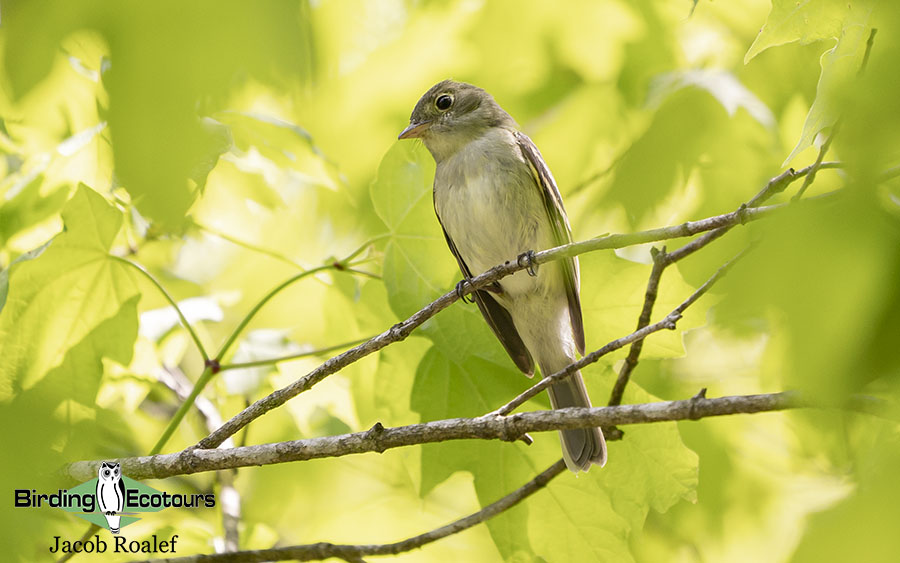
At lunchtime, we enjoyed a picnic on top of a ridge with a scenic overlook whilst being serenaded by Cerulean and Tennessee Warblers. The afternoon was full of more warblers and also some other colorful species like Indigo Bunting, Scarlet Tanager, Wood Thrush and White-eyed Vireo. As we explored the vast forest, we could hear the song of the Acadian Flycatcher, but it took a while before we could get a visual from a very accommodating bird. The rest of the afternoon was spent back near the lodge and cabins. We had an amazing encounter with an extremely territorial Pine Warbler which nearly collided with our heads as he flew along singing! After dinner at the lodge, we met up in the parking lot to listen for Eastern Whip-poor-will. As we were waiting for the sun to set, a few Common Nighthawks flew by overhead and the Chimney Swifts circled around before going to roost. Once it was dark, we managed to hear several Eastern Whip-poor-wills calling and even found one sitting in the road for a moment! This was another great day in the amazing Shawnee Forest.
Day 5, 11th May 2022. Shawnee State Park and back up north
The morning started off with some birding around the lodge and cabins. Cerulean Warblers were singing all around the lodge and we saw our first Blackpoll Warbler of the trip, as well as a small flock of Cedar Waxwings. We headed back to the lodge to have breakfast and pack up our things. After loading the van, we made another quick stop along Route 1 to target a more southern breeding warbler that we still needed. It didn’t take long for us to find a Louisiana Waterthrush. We watched this bird fly up and down along the fast-moving stream for some time before heading out and starting the long drive back north.
The afternoon was spent around Maumee Bay State Park between the beach and the boardwalk. At the inland beach, we picked up Caspian and Forster’s Tern, both new for the trip. It was a pleasant evening for a stroll along the Maumee boardwalk, where we netted eight warbler species, including a few new ones like the glowing Prothonotary Warbler and the chestnut-cheeked Cape May Warbler. Some non-warbler species included Rose-breasted Grosbeak, Baltimore Oriole, Tree Swallow and two different roosting Common Nighthawks. We finished our walk and headed back to the lodge for a nice dinner. We were already up to 26 species of warblers for the trip and were all excited about what the improved weather would mean for the rest of our time along Lake Erie.
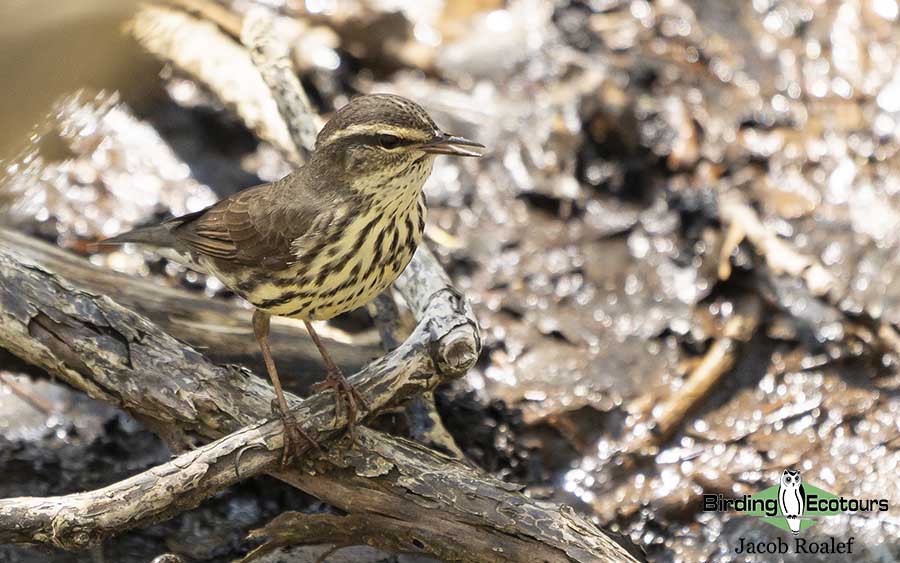
Day 6, 12th May 2022. Oak Openings and Magee Marsh
This morning we headed west and made a stop at Cannonball Prairie, a small park. The prairie and grasslands were fantastic for sparrows and we were not disappointed as we picked up White-crowned, Henslow’s, Grasshopper and Savannah Sparrows. There were also some Orchard Orioles flying around and a couple of Tennessee Warblers feasting on the nectar of nearby flowers. After this great start to our day, we headed over to the amazing oak-savannah habitat of Oak Opening Metropark. This vast park hosted a few breeding species we were still needing. We stopped at tornado alley first, for a quick walk and it yielded one of the absolutely best warblers, a Golden-winged Warbler singing periodically and giving all of us nice, prolonged views. Further up the trail we came across Magnolia Warbler, American Redstart, Northern Cardinal, Scarlet Tanager and Red-headed Woodpecker. Continuing our way through the park, a quick stop in the sandier area netted us Lark and Field Sparrows as well as Eastern Bluebird, American Goldfinch and Nashville Warbler. We made another stop in the northern section of the park when, from the van window, we heard a singing Blue-winged Warbler. We got out of the van and all had a nice view. This was another great pickup and then it was off to lunch.
The post-lunch plan was to head to the Magee Marsh boardwalk and spend the afternoon there. Activity had certainly increased since earlier in the week, with 15 warbler species! Chestnut-sided, Bay-breasted, Blackburnian, Magnolia and Prothonotary Warblers were all observed at such close range that we didn’t even need binoculars to see their beauty and detail. This was all part of the wonder of this area. A skulking Wilson’s Warbler was also added to our warbler list and a Veery in the parking lot area was another nice addition to our trip list. After a nice dinner, we met up at dusk to venture onto some fields near Maumee lodge. As darkness fell, we heard the “peents” of the American Woodcock sounding off and caught a glimpse of it circling high in the air making its display. With a little patience, we eventually got it for a short time in our torch light as it perched along a mowed path. This was a great close to an action-packed day.
Day 7, 13th May 2022. More Magee Marsh and Howard Marsh
On our final full day of the trip, we headed back to Magee Marsh to see what new goodies had dropped in overnight. Birding was excellent and we managed to see 59 species in about three hours, including 19 warblers! Everywhere we turned our heads there was a new bird to be seen. To name just a few, we observed Magnolia, Bay-breasted, American Yellow, Palm, Black-throated Green, Wilson’s, Cape May and Nashville Warblers, plus Scarlet Tanager, Lincoln’s Sparrow, Blue-grey Gnatcatcher, Swainson’s Thrush and Brown Thrasher. All of these species were common as we walked and saw multiples of each, most of which were very close up. We also managed to get on a few special species that did require some patience. A Mourning Warbler made brief appearances as it hid in the dense vegetation, but eventually we all managed a glimpse or more. Additionally, a few Canada Warblers were hanging around, but all of them were being sneaky and difficult to see. With patience and determination, we got on one of these gorgeous birds. Towards the end of our walk, we spotted a Northern Waterthrush strutting its stuff along the forest floor, searching for food. It was fun watching the waterthrush do its thing.
After lunch we headed to Howard Marsh, a new park where some fantastic species have been recorded. We picked up Pied-billed Grebe, Semipalmated Sandpiper, Lesser Scaup, Dunlin, Common Tern, Osprey and Bald Eagle. We also spotted a couple of rare breeding birds (for Ohio) that have made good use of this marsh recently: Yellow-headed Blackbird and Black-necked Stilt. In the early evening, we checked out a different area of Magee Marsh called the Estuary Trail. More amazing warbler action was had as we explored this trail, with Chestnut-sided, Bay-breasted and American Yellow Warblers all over the place. Towards the end of the trail, there was a big commotion amongst other birders, who were looking at a Kirtland’s Warbler. We hurried there and enjoyed some point-blank views of this special warbler, sometimes less than 15 feet (5 meters) from us! The warblers were fantastic, but there were also some other nice species including Eastern Kingbird, Least Flycatcher and Veery. On our way out, we spotted a stunning Philadelphia Vireo which allowed us close views so that we could really study the key features before it flew off. We couldn’t wish for a better final evening to our warbler tour than this and we headed off to dinner to celebrate.
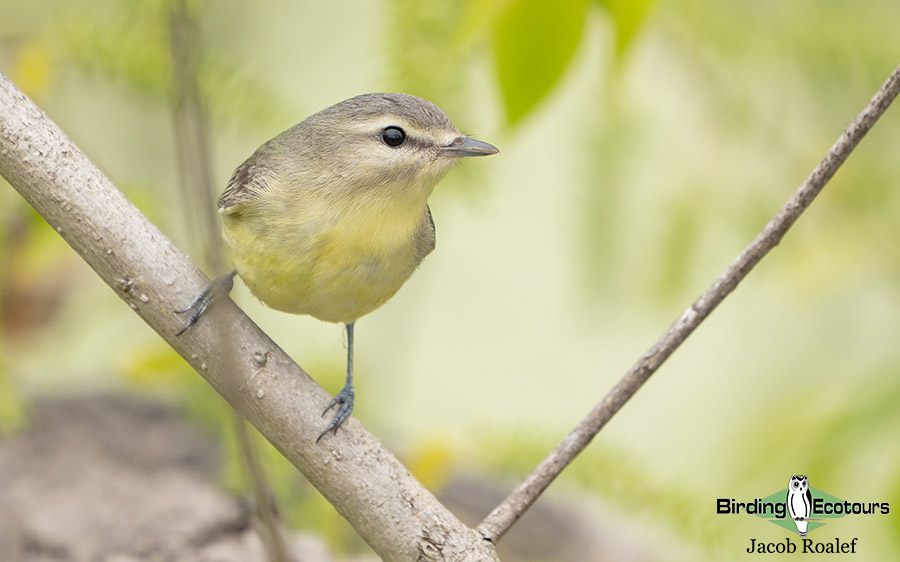
Day 8, 14th May 2022. Departure
Our final morning offered a short optional birding session around the boardwalk of Maumee Bay State Park before breakfast. It was a bit of an overcast morning and the birding was slow. The usual Prothonotary Warblers which breed in this area were out and about and we were treated to a weeping Great Crested Flycatcher. At the end of our walk, just before turning back, we spotted an amazing family of Eastern Screech-Owls! We found mom, dad and four little fluffball babies scattered near the nesting cavity they had recently left. On our walk back we got onto a Hairy Woodpecker which was new for the trip and ended up being species number 150, a lovely round number to end the trip with! After our walk we met up with those who had stayed behind, grabbed some breakfast, packed our things and headed back to the Detroit airport where we said our goodbyes after a truly fantastic week of birding in Ohio.
Bird List – Following IOC (12.1)
Birds ‘heard only’ are marked with (H) after the common name, all other species were seen. Species seen only on the pre-trip day of this trip are marked with (+) after the common name.
The following notation after species names is used to show conservation status following BirdLife International: CE = Critically Endangered, EN = Endangered, VU = Vulnerable, NT = Near Threatened.
| Common Name | Scientific Name |
| Ducks, Geese, Swans (Anatidae) | |
| Canada Goose | Branta canadensis |
| Trumpeter Swan | Cygnus buccinator |
| Wood Duck | Aix sponsa |
| Blue-winged Teal | Spatula discors |
| Gadwall | Mareca strepera |
| Mallard | Anas platyrhynchos |
| Hooded Merganser | Lophodytes cucullatus |
| Lesser Scaup | Aythya affinis |
| Nightjars (Caprimulgidae) | |
| Common Nighthawk | Chordeiles minor |
| Eastern Whip-poor-will | Antrostomus vociferus |
| Swifts (Apodidae) | |
| Chimney Swift – VU | Chaetura pelagica |
| Hummingbirds (Trochilidae) | |
| Ruby-throated Hummingbird | Archilochus colubris |
| Pigeons, Doves (Columbidae) | |
| Rock Dove (Introduced) | Columba livia |
| Mourning Dove | Zenaida macroura |
| Rails, Crakes & Coots (Rallidae) | |
| Sora | Porzana carolina |
| Common Gallinule | Gallinula galeata |
| American Coot | Fulica americana |
| Cranes (Gruidae) | |
| Sandhill Crane | Antigone canadensis |
| Grebes (Podicipedidae) | |
| Pied-billed Grebe | Podilymbus podiceps |
| Stilts and Avocets (Recurvirostridae) | |
| Black-necked Stilt | Himantopus mexicanus |
| Plovers (Charadriidae) | |
| Grey (Black-bellied) Plover | Pluvialis squatarola |
| Semipalmated Plover | Charadrius semipalmatus |
| Killdeer | Charadrius vociferus |
| Sandpipers, Snipes (Scolopacidae) | |
| Dunlin | Calidris alpina |
| American Woodcock | Scolopax minor |
| Spotted Sandpiper | Actitis macularius |
| Lesser Yellowlegs | Tringa flavipes |
| Greater Yellowlegs | Tringa melanoleuca |
| Gulls, Terns, Skimmers (Laridae) | |
| Ring-billed Gull | Larus delawarensis |
| American Herring Gull | Larus smithsonianus |
| Caspian Tern | Hydroprogne caspia |
| Common Tern | Sterna hirundo |
| Forster’s Tern | Sterna forsteri |
| Cormorants and Shags (Phalacrocoracidae) | |
| Double-crested Cormorant | Nannopterum auritum |
| Herons, Egrets, and Bitterns (Ardeidae) | |
| Green Heron | Butorides virescens |
| Great Blue Heron | Ardea herodias |
| Great Egret | Ardea alba |
| Pelicans (Pelecanidae) | |
| American White Pelican | Pelecanus erythrorhynchos |
| New World Vultures (Cathartidae) | |
| Black Vulture | Coragyps atratus |
| Turkey Vulture | Cathartes aura |
| Ospreys (Pandionidae) | |
| Western Osprey | Pandion haliaetus |
| Kites, Hawks, Eagles (Accipitridae) | |
| Cooper’s Hawk | Accipiter cooperii |
| Bald Eagle | Haliaeetus leucocephalus |
| Red-tailed Hawk | Buteo jamaicensis |
| Owls (Strigidae) | |
| Great Horned Owl | Bubo virginianus |
| Eastern Screech Owl | Megascops asio |
| Kingfishers (Alcedinidae) | |
| Belted Kingfisher | Megaceryle alcyon |
| Woodpeckers (Picidae) | |
| Red-headed Woodpecker | Melanerpes erythrocephalus |
| Red-bellied Woodpecker | Melanerpes carolinus |
| Downy Woodpecker | Dryobates pubescens |
| Hairy Woodpecker | Leuconotopicus villosus |
| Northern Flicker | Colaptes auratus |
| Pileated Woodpecker | Dryocopus pileatus |
| Tyrant Flycatchers (Tyrannidae) | |
| Eastern Phoebe | Sayornis phoebe |
| Eastern Wood Pewee | Contopus virens |
| Acadian Flycatcher | Empidonax virescens |
| Least Flycatcher | Empidonax minimus |
| Eastern Kingbird | Tyrannus tyrannus |
| Great Crested Flycatcher | Myiarchus crinitus |
| Vireos, Shrike-Babblers, and Erpornis (Vireonidae) | |
| Red-eyed Vireo | Vireo olivaceus |
| Philadelphia Vireo | Vireo philadelphicus |
| Warbling Vireo | Vireo gilvus |
| Yellow-throated Vireo | Vireo flavifrons |
| Blue-headed Vireo | Vireo solitarius |
| White-eyed Vireo | Vireo griseus |
| Crows, Jays, and Magpies (Corvidae) | |
| Blue Jay | Cyanocitta cristata |
| American Crow | Corvus brachyrhynchos |
| Waxwings (Bombycillidae) | |
| Cedar Waxwing | Bombycilla cedrorum |
| Tits, Chickadees, and Titmice (Paridae) | |
| Tufted Titmouse | Baeolophus bicolor |
| Carolina Chickadee | Poecile carolinensis |
| Black-capped Chickadee | Poecile atricapillus |
| Larks (Alaudidae) | |
| Horned Lark | Eremophila alpestris |
| Swallows (Hirundinidae) | |
| Tree Swallow | Tachycineta bicolor |
| Northern Rough-winged Swallow | Stelgidopteryx serripennis |
| Purple Martin | Progne subis |
| Barn Swallow | Hirundo rustica |
| American Cliff Swallow | Petrochelidon pyrrhonota |
| Wrens (Troglodytidae) | |
| Carolina Wren | Thryothorus ludovicianus |
| House Wren | Troglodytes aedon |
| Gnatcatchers (Polioptilidae) | |
| Blue-grey Gnatcatcher | Polioptila caerulea |
| Nuthatches (Sittidae) | |
| White-breasted Nuthatch | Sitta carolinensis |
| Mockingbirds, Thrashers (Mimidae) | |
| Grey Catbird | Salpinctes obsoletus |
| Northern Mockingbird | Catherpes mexicanus |
| Brown Thrasher | Cistothorus palustris |
| Starlings, Rhabdornis (Sturnidae) | |
| Common (European) Starling | Sturnus vulgaris |
| Thrushes and Allies (Turdidae) | |
| Eastern Bluebird | Sialia sialis |
| Wood Thrush (H) | Hylocichla mustelina |
| Swainson’s Thrush | Catharus ustulatus |
| Veery | Catharus fuscescens |
| American Robin | Turdus migratorius |
| Old World Sparrows, Snowfinches (Passeridae) | |
| House Sparrow | Passer domesticus |
| Finches, Euphonias (Fringillidae) | |
| House Finch (Introduced) | Haemorhous mexicanus |
| American Goldfinch | Spinus tristis |
| New World Sparrows (Passerellidae) | |
| Grasshopper Sparrow | Ammodramus savannarum |
| Lark Sparrow | Chondestes grammacus |
| Chipping Sparrow | Spizella passerina |
| Field Sparrow | Spizella pusilla |
| Dark-eyed Junco | Junco hyemalis |
| White-crowned Sparrow | Zonotrichia leucophrys |
| White-throated Sparrow | Zonotrichia albicollis |
| Henslow’s Sparrow | Centronyx henslowii |
| Savannah Sparrow | Passerculus sandwichensis |
| Song Sparrow | Melospiza melodia |
| Lincoln’s Sparrow | Melospiza lincolnii |
| Eastern Towhee | Pipilo erythrophthalmus |
| Yellow-breasted Chat (Icteriidae) | |
| Yellow-breasted Chat | Icteria virens |
| Oropendolas, Orioles, Blackbirds (Icteridae) | |
| Yellow-headed Blackbird | Xanthocephalus xanthocephalus |
| Baltimore Oriole | Icterus galbula |
| Orchard Oriole | Icterus spurius |
| Red-winged Blackbird | Agelaius phoeniceus |
| Brown-headed Cowbird | Molothrus ater |
| Common Grackle | Quiscalus quiscula |
| New World Warblers (Parulidae) | |
| Ovenbird | Seiurus aurocapilla |
| Worm-eating Warbler | Helmitheros vermivorum |
| Louisiana Waterthrush | Parkesia motacilla |
| Northern Waterthrush | Parkesia noveboracensis |
| Golden-winged Warbler | Vermivora chrysoptera |
| Blue-winged Warbler | Vermivora cyanoptera |
| Black-and-white Warbler | Mniotilta varia |
| Prothonotary Warbler | Protonotaria citrea |
| Tennessee Warbler | Leiothlypis peregrina |
| Nashville Warbler | Leiothlypis ruficapilla |
| Mourning Warbler | Geothlypis philadelphia |
| Kentucky Warbler | Geothlypis formosa |
| Common Yellowthroat | Geothlypis trichas |
| Hooded Warbler | Setophaga citrina |
| American Redstart | Setophaga ruticilla |
| Kirtland’s Warbler (Rarity) | Setophaga kirtlandii |
| Cape May Warbler | Setophaga tigrina |
| Cerulean Warbler | Setophaga cerulea |
| Northern Parula | Setophaga americana |
| Magnolia Warbler | Setophaga magnolia |
| Bay-breasted Warbler | Setophaga castanea |
| Blackburnian Warbler | Setophaga fusca |
| American Yellow Warbler | Setophaga aestiva |
| Chestnut-sided Warbler | Setophaga pensylvanica |
| Blackpoll Warbler | Setophaga striata |
| Black-throated Blue Warbler | Setophaga caerulescens |
| Palm Warbler | Setophaga palmarum |
| Pine Warbler | Setophaga pinus |
| Myrtle Warbler | Setophaga coronata |
| Yellow-throated Warbler | Setophaga dominica |
| Prairie Warbler | Setophaga discolor |
| Black-throated Green Warbler | Setophaga virens |
| Canada Warbler | Cardellina canadensis |
| Wilson’s Warbler | Cardellina pusilla |
| Cardinals and Allies (Cardinalidae) | |
| Scarlet Tanager | Piranga olivacea |
| Rose-breasted Grosbeak | Pheucticus ludovicianus |
| Northern Cardinal | Cardinalis cardinalis |
| Indigo Bunting | Passerina cyanea |
| Total Seen | 149 |
| Total Heard | 1 |
| Total Recorded | 150 |
Mammal List
| Common Name | Scientific Name |
| Squirrels and Relatives (Sciuridae) | |
| Woodchuck | Marmota monax |
| Eastern Gray Squirrel | Sciurus carolinensis |
| Eastern Fox Squirrel | Sciurus niger |
| Eastern Chipmunk | Tamias striatus |
| Rodents (Cricetidae) | |
| Muskrat | Ondatra zibethicus |
| Rabbits and Hares (Leporidae) | |
| Eastern Cottontail | Sylvilagus floridanus |
| Raccoons and Relatives (Procyonidae) | |
| Northern Raccoon | Procyon lotor |
| Deer, Elk, Mooses (Cervidae) | |
| White-tailed Deer | Odocoileus virginianus |
| Total Seen | 8 |
USA: Ohio – Eastern Warblers and Spring Migration Spectacular
Tour-specific Information
PASSPORT AND VISA
For US citizens, no visas or passports are required. You will however need to bring along a government issued ID as they are sometimes required for hotels.
Non-United States citizens will require a valid passport to enter the country, and some may require a tourist visa. Please consult with your local US embassy for more details and information. You may need to show your ID/passport at various hotels on this tour.
TRAVEL INSURANCE
We strongly encourage you to purchase trip cancellation or interruption insurance in case you have to cancel due to illness or for any other reason, as tour payments are non-refundable as per our terms and conditions. We advise you to get a plan which covers all your medical care and evacuation back to your country of residence, repatriation, and trip cancellation due to illness just prior, or for any other reason.
HEALTH
Ohio does not pose any major health risks. Longer drives in the vehicle will be broken up with birding and restroom stops. Temperatures in May are typically pleasant but can be chilly in the mornings and warm during the day, please see ‘Weather/Climate’ below for more details. Water will be available throughout the tour, please feel free to bring your own reusable bottle to refill throughout the tour as the drinking water here is safe. Ticks and other insects may be present but typically they do not arrive until summer and can be combatted with bug spray (DEET) and appropriate clothing (long-sleeved shirts and trousers).
MEDICAL CONDITIONS
Please make sure that you are covered by medical insurance in case of an emergency while on this trip. Without insurance the cost of medical care can be extremely high. Please notify us at the time of registering for this tour of any medical conditions you think we should know about (including allergies, heart conditions, epilepsy, etc.). This will greatly help us to cater to your needs and update emergency services if required.
WEATHER/CLIMATE
The weather in Ohio in the spring is unpredictable and can vary drastically from 30 °F (0 °C) in the morning (even snow, rarely) to up to 80 °F (27 °C) on warm sunny days. Rain, wind, fog, and sunshine are all possible and sometimes all can occur in one day! Layers are the key to Ohio weather and shedding layers as the day progresses is a normal occurrence.
ACCOMMODATIONS
We will be staying at comfortable hotels throughout the tour.
COMMUNICATIONS
Our hotels should have decent access to Wi-Fi throughout the trip and phone service is typically fine throughout Ohio with the potential for some spotty coverage while out in the field, particularly when closer to the Canadian border.
PHYSICAL REQUIREMENTS AND PACE OF TOUR
Most days begin early (7 am or earlier for breakfast) to get out in time for the chorus of new migrant arrivals. We will then be birding up until dinner with some potential evening excursions, so the days can add up and be long and tiring. There will be options however to take certain mornings or afternoons off, if needed.
Ohio is typically flat with nice trails, and a lot of birding can be done close to the vehicle, however due to the long days of birding, the total amount of walking can add up in a day. Of course, there is the option to stay with the vehicle at times and bird from there which should also yield nice species. There are a few longer drives when going between northern and southern Ohio and then up to Michigan. These will be broken up with birding and restroom stops.
WHAT TO BRING
Please kindly read the general list of what to bring on a birding tour, here.
Layers and waterproof gear are always a good idea when preparing for a wide variety of possible weather conditions, and we consider them essential on this tour. We also do recommend bringing Dramamine or other motion sickness medications if you need them as there are long drives in the vehicle. Also, please bring along a face mask (or a few) to ensure we are able to follow local guidelines during the Covid-19 pandemic as they will be required in certain areas.
Do not forget – Binoculars, prescription drugs (also bring the generic names for these drugs), toiletries, prescription glasses (and a spare pair), sunglasses, camera, batteries (for electronic equipment and chargers for re-chargeable batteries if required), alarm clock, money pouch, field guide(s), daypack.
Key Documents and Cash – Passports, your travel or health insurance cards, photocopies of which can be carried by the tour leader in case of emergency, Covid-19 vaccine card (or photo/copy), credit cards (see info above). US dollars for drinks, gifts, tips, items of a personal nature, etc., which are not included in the tour cost.
LUGGAGE
There should be enough space for each participant to bring one medium-sized suitcase as well as a personal bag to keep at their seat with them. Please do be mindful with large cameras or tripods, if you choose to bring these along.
Download Ohio: Eastern Warblers and Spring Migration Spectacular Information
Jacob was extremely well informed, considerate of the personal needs of each participant, and resourceful at finding and showing participants target birds. The trip was well-paced, kept on schedule, and went well. Not a moment was wasted. The places we stayed were excellent and close to the areas where we birded. We saw an incredible number and variety of warblers, went out at night to see a woodcock and a whip-or-will, and were introduced to every aspect of an exciting birding environment. I highly recommend this trip.

